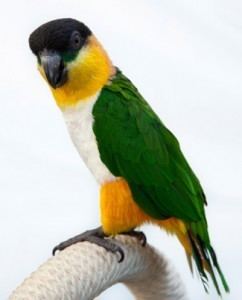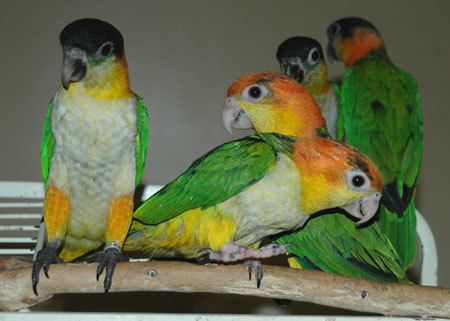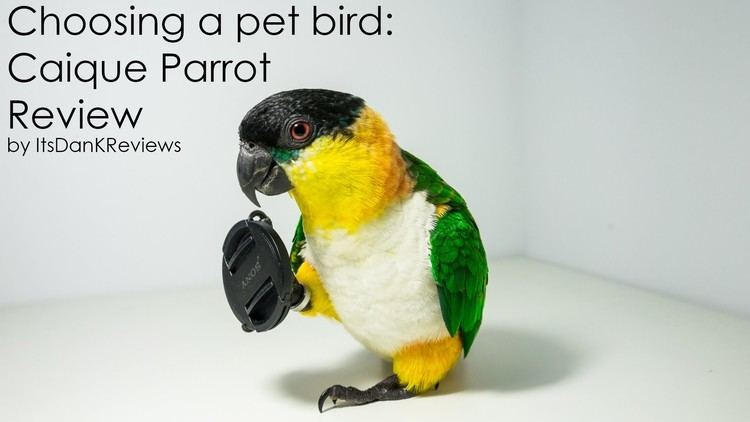Order Psittaciformes Scientific name Pionites Rank Genus | Phylum Chordata Superfamily Psittacoidea Subfamily Arinae Higher classification Neotropical parrot | |
 | ||
Lower classifications Black‑headed parrot, Green‑thighed parrot | ||
Choosing a pet bird caique parrot review
The caiques (/kaɪˈiːk/ or /kɑːˈiːk/) are species of parrots in the genus Pionites. They are relatively small and stocky, with a short, square tail and very bright colors. Their typical weight is 150–170 grams. They can live up to 40 years. They are endemic in the Amazon Basin in South America, with the black-headed north of the Amazon River, and the white-bellied south. They are listed on Appendix 2 of CITES as a species of least concern. They generally prefer forested areas and subsist on fruit and seeds. Caiques are generally canopy dwellers, spending most of their time in the tops of trees, foraging and playing. Caique wing feathers produce a distinctive whirring sound in flight. They are highly vocal.
Contents
- Choosing a pet bird caique parrot review
- Baby white bellied caiques learning to fly
- Taxonomy and systematics
- Behavior and ecology
- Aviculture
- References

Baby white bellied caiques learning to fly
Taxonomy and systematics

Originally Pionites had two species, the black-headed parrot and white-bellied parrot. However, recent morphological work has indicated that the white-bellied parrot should be split into three species based on plumage and leg coloration. In the past these parrots were often allied with the conures or other South American parakeets, recent mitochondrial and nuclear DNA work has found Pionites being the sister taxon to the Deroptyus (the genus that contains the red-fan parrot); the two genera occupy a basal position in the tribe Arini.
Behavior and ecology

These parrots are found in the edges of forests and secondary-growth forests. They usually forage on at higher levels in the canopy, although can also be found lower at forest edges. At least two members of the flock acted as sentries during feeding time. Their diet consists of flowers, fruit, pulp, and seeds, although in captivity they are known to eat insects. Depending on the species and the location, they can breed from October to May at various times of the year. Caiques are high-nesting cavity birds and roost communally. The number of the flock is usually around 10 to 30 individuals.

The species of the white-bellied parrot complex is found in humid forest and wooded habitats in the Amazon south of the Amazon River in Bolivia, Brazil, and Peru. It is generally fairly common throughout its range and is easily seen in a wide range of protected areas, such as the Manú National Park and Tambopata-Candamo in Peru, Cristalino State Park (near Alta Floresta), Xingu National Park and Amazônia National Park in Brazil, and Madidi National Park in Bolivia.

The black-headed parrot is found in forest (especially, but not exclusively, humid) and nearby wooded habitats in the Amazon north of the Amazon River and west of the Ucayali River in Brazil, northern Bolivia, Colombia, Ecuador, French Guiana, Guyana, Peru, Suriname, and Venezuela. It is generally fairly common and occurs in many protected areas throughout its range.
Aviculture

Caiques are growing in popularity in aviculture. The more commonly found species is the black-headed caique since it was introduced first in captivity, but the white-bellied caique's popularity is growing rapidly. Well-raised caiques bond well with humans and have a reputation as playful and energetic birds that enjoy playing with toys and lying on their backs, as shown in the photo on the right. These birds sometimes perform a behavior unusual for avian species in which they roll over on their backs in apparent play - sometimes called "wrestling". They are not particularly good flyers, becoming tired and winded after only a short distance. They also tend to be clumsy and slow in the air compared to other birds. They often prefer to walk, jump, climb, or hop as a mode of transportation. They are excellent climbers, with very strong feet and legs.
Caiques also exhibit a unique behavior known as "surfing", where the bird will vigorously rub its face, wings and chest against any nearby soft item (e.g. carpets, towels, cushions, crumpled paper, curtains or human hair) while using its beak to pull itself along. During this, the bird will display jerky movements and may roll over several times. This behavior is thought to be a cleaning or bathing motion and occurs regardless of age or sex. In the wild, caiques use wet leaves for this behavior.
In captivity caiques are capable of breeding at under three years of age. They typically lay a clutch of four eggs, with incubation taking between 24–27 days. Most pairs will however struggle to raise all four chicks, with often the last chick to hatch not surviving unless it is taken for hand-rearing or co-parenting. Chicks are fed by both parents and remain in the nest box for approximately 70–75 days. Parents can be very affectionate towards their offspring and after the chicks have fledged they will return to the nest box each night with their parents where the family will roost as a group.
